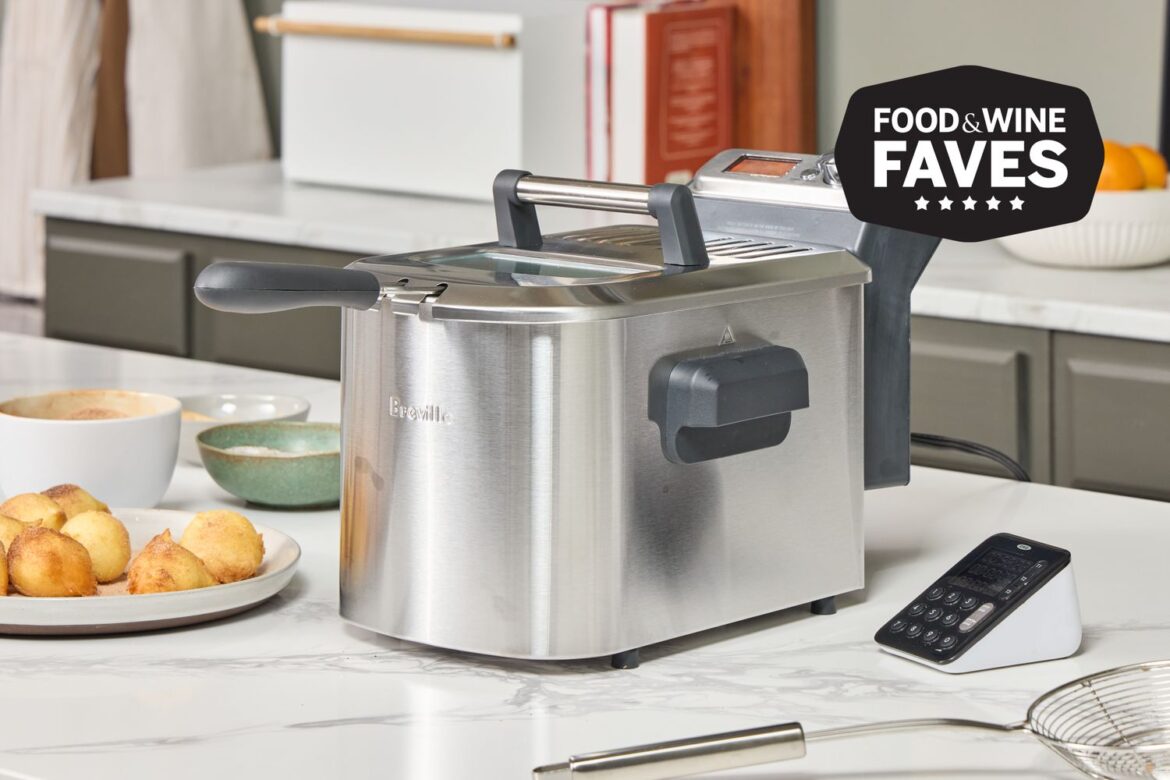Few things are as satisfying as biting into a shatteringly crisp potato chip or French fry hot out of the bubbling oil, but for most home cooks, that’s an infrequent pleasure. Deep-frying is one of those techniques we usually leave to restaurants. It’s a bit of a project. It can be time-consuming, messy, and liable to cause splatter burns. But it doesn’t have to be.
Modern deep fryers are easier to use than ever. Some of the best deep fryers have digital displays, timers, baskets, and overheating alarms that practically automate the process. With a good deep fryer, there’s no more guessing the oil temperature in your Dutch oven or finding the candy thermometer. Here’s what we found by testing 21 deep fryers.
Our Favorite Deep Fryer
The Smart Fryer from Breville is our favorite deep fryer for its intuitive digital controls and excellent heat management. A close runner-up was the Hamilton Beach Deep Fryer, which performed nearly as well in an analog format.
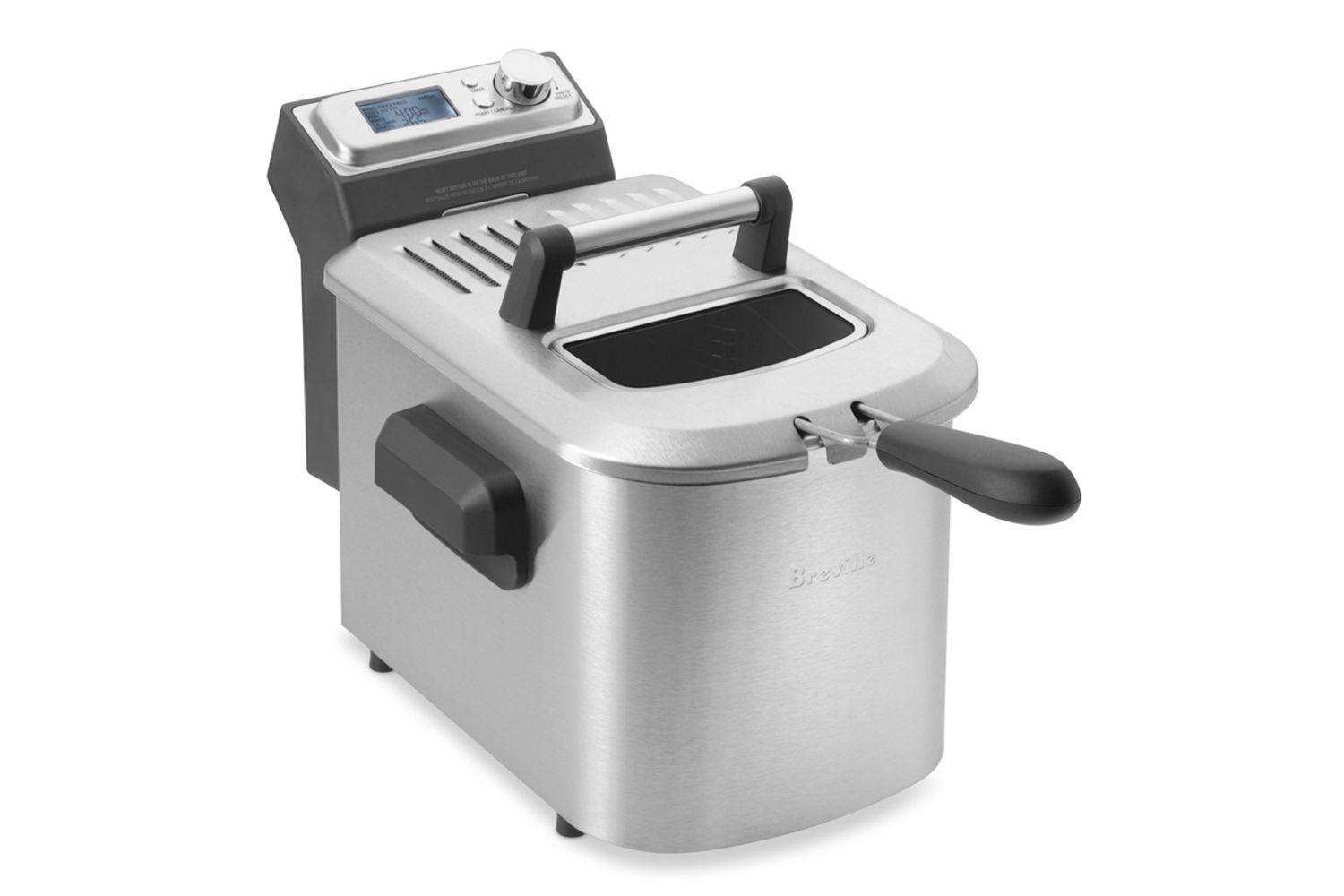
Credit: Williams Sonoma
Breville is the returning champion with the Smart Fryer. Its traditional brushed-metal exterior looks sleek on a countertop, while an easy-to-read control panel contains seven cooking presets, a fresh/frozen food selector, and easy temperature customization. A couple of other features include a temperature control device to boost heating power after dropping cold food into the oil and a cool zone under the heating element, which prevents food debris from burning in the hot oil.
In our testing, we found that the Smart Fryer was simple and intuitive to get ready for cooking. After filling the fryer with oil and selecting the temperature via the select/control knob, the oil heated to 375°F in 10 minutes and it was time to cook. The frozen French fries, cooked using the “frozen” selection, and chicken tenders both come out brown and crisp with soft or tender interiors, albeit with a touch of oil remaining on the surface. The doughnuts were soft inside with just a touch of crispness on the outside. As the key to perfect frying is consistent temperature, the amount the temperature drops after adding food and the time it takes to recover are crucial. The fries dropped the temperature by 40°F and took four minutes to recover. Adding the chicken tenders dropped the temperature by 25°F, and it took three minutes to recover.
Cleaning was the only negative we could find with the Smart Fryer. Many of the models we tested had an oil filtration system, but this one did not. That aside, cleaning this fryer was still very easy. All the internal parts, except the combination control panel and heating element, are dishwasher-safe.
Dimensions: 15.51 x 10.51 x 10.24 inches | Capacity: 4 quarts | Power: 1,800 watts | Temperature Range: 250° – 380°F
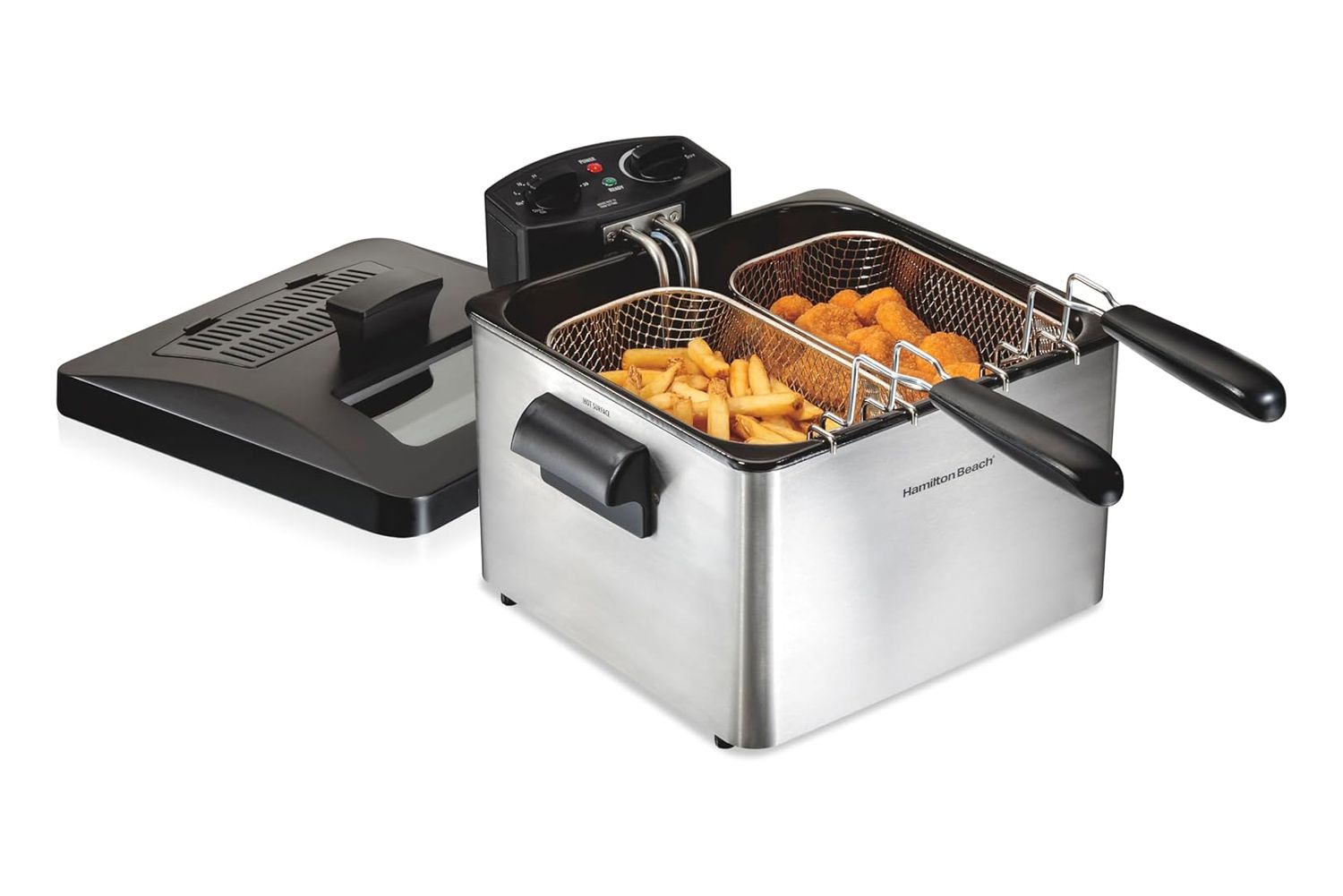
Credit: Amazon
Pros
The Hamilton Beach is a mid-priced model that offers great heating and recovery, delivering crisp, browned, and non-greasy results.
It was a tough decision between our Best Overall and Runner-Up picks. The Hamilton Beach was also easy and intuitive to get started with, utilizing analog dial controls for the settings. The two-basket configuration provides ample room for food without overloading, and the large capacity prevents the temperature from dropping too drastically. After filling the fryer, we reached frying temperature in 15 minutes. The temperature dropped 35°F after adding the French fries, but recovered within three minutes, while it only dropped 25°F after adding chicken tenders.
The fries showed a nice brown color, crispy on the outside and soft inside, and the chicken had a similar color and texture, with hot and tender centers. The doughnuts were light, soft, and had just a bit of crisp on the exterior. This large fryer provided plenty of room for the doughnuts to cook without crowding. The Hamilton Beach was also without a grease drain or filtration system, but it was easy enough to empty the fryer manually. The baskets, oil pot, and lid were all dishwasher-safe, making the cleanup task easy. Minus the technological differences of the Smart Fryer, the Hamilton Beach delivered similar results at a much lower price point.
Dimensions: 10.5 x 13.2 x 14.5 inches | Capacity: 19 cups | Power: 1,800 watts | Temperature Range: 265° – 375°F
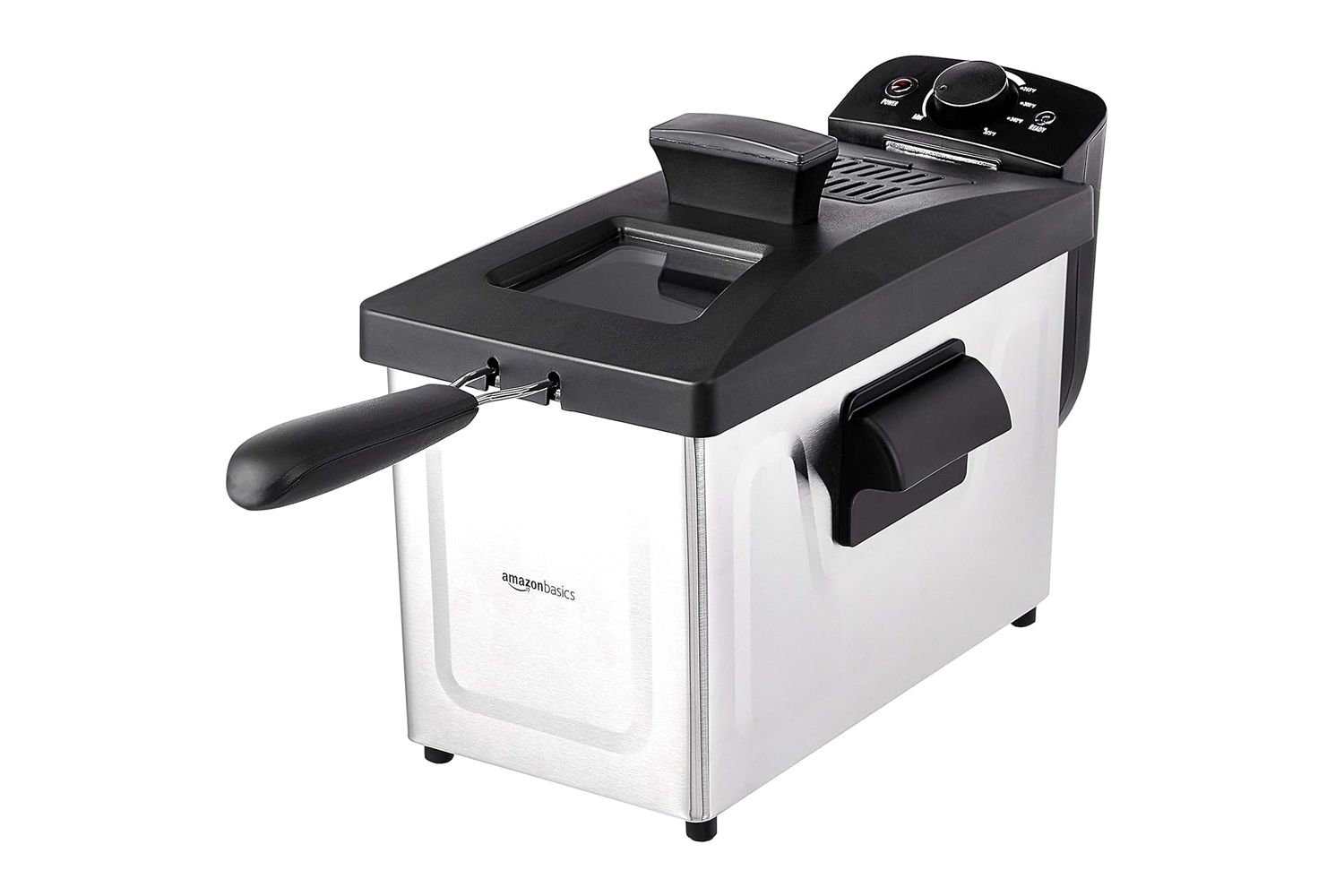
Credit: Amazon
Sometimes good things come in small packages. This fryer from Amazon Basics has a compact footprint that won’t consume too much counter space or cabinet space. It has simple analog controls that offer settings at 265°, 300°F, 340°, and 375°F. There are no in-between settings available. We couldn’t get the fryer to its hottest temperature, instead maxing out at 360°F. But the French fries and chicken tenders emerged nicely browned and crisp, although the fries had a slightly oily taste. The doughnuts were nicely crisp on the outside and soft in the middle, with no oily film.
Throughout the testing, the fryer ran a few degrees cooler than the set temperature, and the lid would benefit from better venting, as condensation accumulated during the frying process. That condensation is likely the culprit of the lower temperatures and caused more spattering than expected. Cleaning was easy, but this is another model without an oil filtration system, so pouring it out by hand is the only option. After that, dealing with that particularly messy part, the basket, oil pot, lid, and even the external housing are all dishwasher safe, making the second phase of cleanup quick. Given its small footprint, ease of cleaning, and price, we can forgive the slow temperature response we observed and consider this fryer a value pick.
Dimensions: 15.91 x 8.9 x 9.37 inches | Capacity: 2 quarts | Power: 1,500 watts | Temperature Range: 265° – 375°F
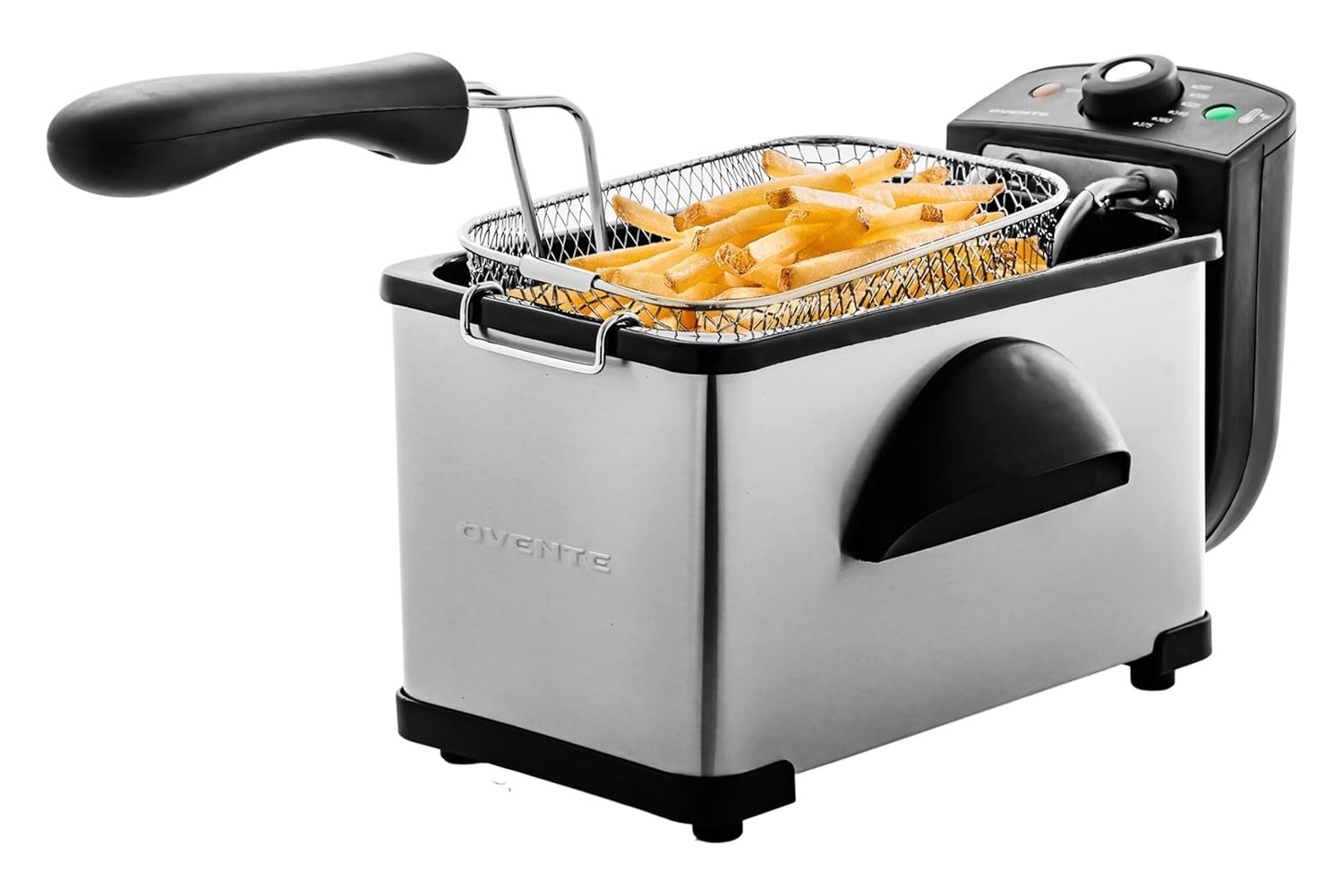
Credit: Amazon
Pros
This small fryer won’t hog your countertop, has great heat recovery, and costs less than others on our list.
The Ovente is another compact fryer that’s worth a permanent place on your countertop without being obtrusive. It’s a small fryer with a 2-quart (2-liter) capacity, featuring simple, analog controls, but it sports a brushed-metal finish that ratchets up the style points a bit. How did it perform?
It held a stable temperature throughout the test rounds, and the fries cooked perfectly in about two minutes and 20 seconds. The chicken tenders had similarly pleasing results, and the doughnuts were nicely soft and slightly crisp, with no trace of greasiness. Most of the components are dishwasher-safe, but manually emptying the oil pot is always dicey. One strong word of warning: The lid traps a considerable amount of condensation. While it significantly minimized “fryer odors,” the amount of condensation collected after a four-minute fry resulted in a lot of oil popping when removing the lid.
Dimensions: 13.75 x 8.25 x 8.25 inches | Capacity: 2 quarts | Power: 1,500 watts | Temperature Range: 275° – 375°F
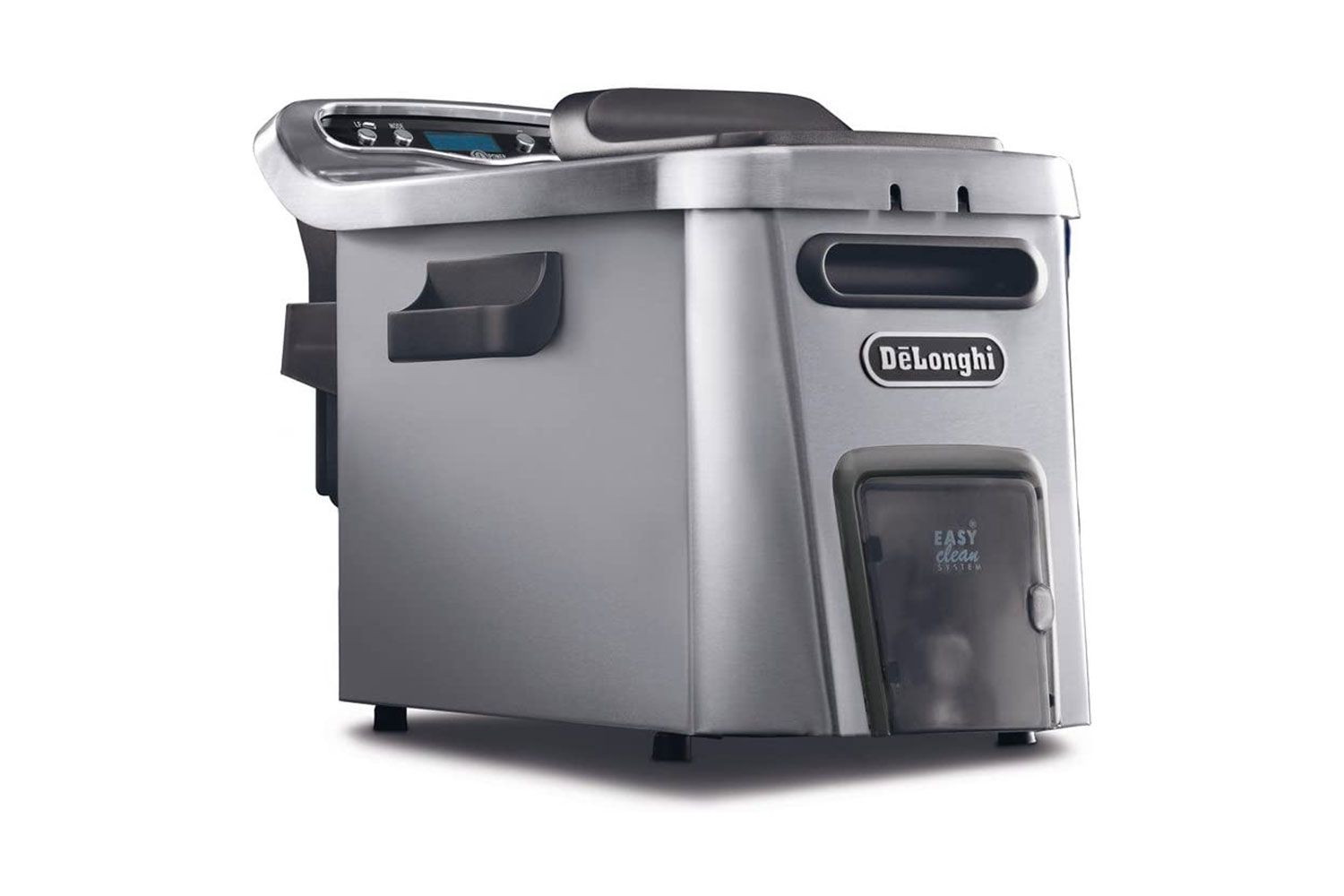
Credit: Amazon
The Livenza is the highest-capacity fryer among our top picks, holding a gallon of oil. The digital controls and LED display lack presets, but that allows easier manual temperature adjustment to fine-tune recipes. The single high-capacity basket held French fries and chicken fingers easily with no crowding. Both foods emerged with a bit of greasiness, but the chicken fingers had nice browning, and the fries had a light crispness to them. The recovery time for each was within reason, but could have been better had we kept the lid closed throughout cooking. A gallon of fryer oil is something to consider when cleaning, and the Livenza’s filtration system and drain make the job cleaner and much easier. The high capacity, digital controls, and filtration system make this a strong choice for folks who regularly fry for larger groups.
Dimensions: 12.5 x 18 x 11 inches | Capacity: 1 gallon | Power: 1,800 watts | Temperature Range: 248° – 374°F
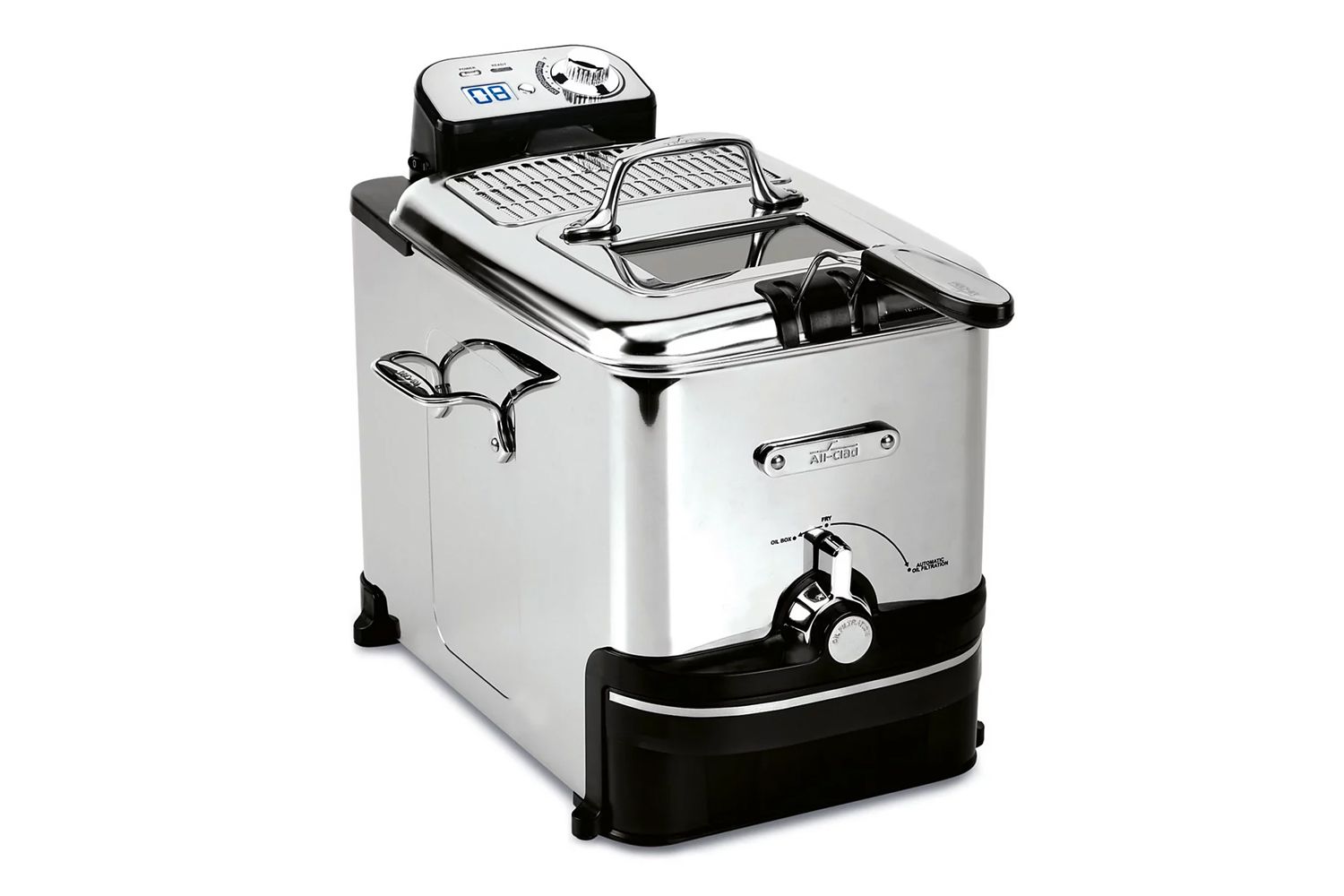
Credit: Wayfair
The All-Clad is another returning winner after our latest round of testing. The oil filtration system is a big plus, as dealing with used fryer oil is the least pleasant part of home deep frying. The oil filters from the fry pot into a box, which the user can then remove to drain into a storage vessel for future use (or discarding). The control panel consists of a temperature selector knob and an LED display that shows the timer and temperature.
The basket is wider than it is deep, and while we had no issues with fries or doughnuts, completely submerging chicken tenders required a bit of poking and prodding. All three items came out of the oil with good results. The fries showed nice browning, although they were a bit dense in the center. The chicken tenders, after getting them to sit nicely in the oil, were hot and moist in the center and not greasy. The doughnuts had a wonderfully soft center. The fryer took about 20 minutes to reach temperature, and although we witnessed a steep temperature drop after adding the fries, it recovered nicely.
Dimensions: 18.2 x 13.7 x 14.7 inches | Capacity: 3.5 liters | Power: 1,700 watts | Temperature Range: 300° – 375°F
How We Tested Deep Fryers
Over the last few years, we’ve tested 19 deep fryers. Although the test methodology varied slightly between test rounds, we reviewed them on the same main points: design, ease of assembly, ease of use, results, and cleanup. Here’s what our latest tests looked like.
Setup Test: We took each model from the packaging and assembled it according to the manufacturer’s instructions. We judged the ease of the process and the clarity of instructions. When assembled, we recorded our observations of each fryer’s overall size and appearance.
French Fry Test: To assess the clarity of operational instructions and the intuitiveness of the controls, we heated each fryer to a preassigned temperature and added one pound of frozen fries. As the cold French fries lowered the temperature of the hot oil, we recorded how far the temperature dropped and how long it took for the oil to regain its cooking temperature. Then we examined the appearance of the fries, their texture, and if any greasiness remained on the surface.
Chicken Tender Test: While the French fry test examined the results of thin, individual foods, a chicken tender represents a denser food, and we needed to know how each fryer performed. Again, we set the fryers to a preassigned temperature and added 12 ounces of frozen chicken tenders. We recorded the temperature drop and recovery time again, and then evaluated the tenders for taste, texture, color, and doneness.
Doughnut Test: To examine each fryer’s performance at lower temperatures, we prepared doughnut batter and fried doughnut holes according to the recipe. We observed how well the doughnut holes fit in the fryer, noting any crowding, and again recorded the temperature drop and recovery time. Of course, we had to taste test, and we looked for a light crispness on the outside and soft interiors.
Food & Wine
Factors to Consider
Capacity
The indoor fryers we tested can hold anywhere from a single quart to more than a gallon of oil. More oil means you can fit more food at once, and a larger amount of oil will also hold its temperature better during the cooking process. On the other hand, oil is expensive and you don’t need a huge machine to fry a single serving at once. For best results, you want whatever you’re frying to have enough room to float freely without individual pieces sticking together.
It’s also important never to overfill your fryer. Check the manual for details about proper oil fill levels and how much food can go in at once. If you’re frying a turkey, you should do a test run using water to determine the exact correct amount of oil; turkey-fryer overflow can cause a serious fire.
Food & Wine
Safety Features
Deep-frying requires extra care in the kitchen: A vat full of hot oil is no joke, and you want to be sure that you’re set up for safety, especially if you’re a beginner. Many deep fryers have magnetic cords that automatically disengage when something yanks them to prevent accidentally tipping over. Handles and exteriors are often heat-resistant, and there are also commonly sensors that cut off the heat if it gets too high or if the oil level gets too low. Lids that cover oil during cooking can be helpful, especially if they have a clear lid to let you observe your food. Some of these are difficult to open and close, however, and others are poorly ventilated and can trap and condense steam to cause splatters.
Food & Wine
Settings and Options
If you fry a variety of foods, you may want a unit with more bells and whistles. Fancier fryers not only let you set a temperature and timers but also have preset programs designed for specific foods, plus a screen that displays all the info you need. Simpler ones have an on switch and… not much else. Multiple baskets can also be helpful for multi-course meals or a house with picky eaters. These let you remove one batch from the oil while another continues cooking — and ensure that the fish folks and chicken folks don’t have to have their proteins mingling.
Food & Wine
Cleanup
Working with oil is always going to be messy, so finding a fryer that helps to mitigate excessive scrubbing is important. The worst part of cleanup is usually getting the oil and crumbs out of the machine; a few models have a drainage spigot and filter, while many others have a removable oil bowl you have to dump out on your own. The more pieces that disassemble, and the more of them that are dishwasher-safe, the easier it is to clean your machine.
Just like with a slow cooker or mini slow cooker, the part of an indoor deep fryer that is usually the most complicated to clean is the heating element. This part is submerged in oil during cooking, but it’s also connected to a plug and has to stay away from being submerged in water. Check your machine’s instructions for the exact procedure, but you’ll generally have to wipe this piece down with a soapy cloth or sponge, then rinse and dry carefully.
Food & Wine
Other Deep Fryers We Tested
Strong Contenders
T-fal 3.5-Liter Stainless Steel Deep Fryer with Basket ($157 at Amazon)
The T-fal’s strongest feature is the oil filtration system. Used on its own, dialing in the frying temperature was troublesome, and we recommend using an external thermometer for temperature monitoring, as the internal thermometer registered significantly cooler temperatures and turned the heating element off prematurely.
Elite Gourmet Dual Basket Deep Fryer with Lid ($85 at Amazon)
The Elite Gourmet scored well in our tests, just not quite as well as our top picks. It produced excellent fries, crispy chicken, and soft doughnuts. Yet, the temperature fluctuated by 10°F on either side of the target after heating and struggled to regain its temperature after dropping food into the oil.
Presto FryDaddy Deep Fryer ($44 at Amazon)
An icon since 1977, this tiny fryer stood out in testing for its quick heating, overall heat retention, and low price. It is no-frills, however, with no internal thermometer or ability to adjust the frying temperature. It does the basics well at an extremely low price, but it’s very small and pretty tough to clean.
Presto Dual Basket ProFry ($90 at Amazon)
Presto’s larger model took a long time to heat up, though, and all of our test foods came out a little greasy. Plus, none of the parts are dishwasher-safe. There are better basic machines in the same price range.
Cuisinart 4-Quart Deep Fryer ($86 at Amazon)
Where many of the other models we tested fought to maintain or recover temperature, the Cuisinart retains heat possibly too well, racing past the desired temperature in our tests. An experienced cook with an accurate thermometer would have no problems adjusting to the temperature variations, but this is otherwise a very standard machine at a somewhat below-average price.
Food & Wine
What Didn’t Make the List
The main problem we found with poorly performing machines was a lack of power: They simply didn’t heat the oil quickly enough to keep food from winding up limp and greasy rather than crisp and crunchy. Many models include a lid to help hold in heat, but some of these caused an additional issue by trapping steam that dripped back into the oil and caused splatters. Cleaning was another important consideration: A few models had okay cooking performance but were pushed off the list for being a huge pain to disassemble and scrub.
Our Expertise
Greg Baker is an award-winning chef, restaurateur, and food writer with decades of experience in the food industry. His written work appears in Food & Wine, Food Republic, and other publications

